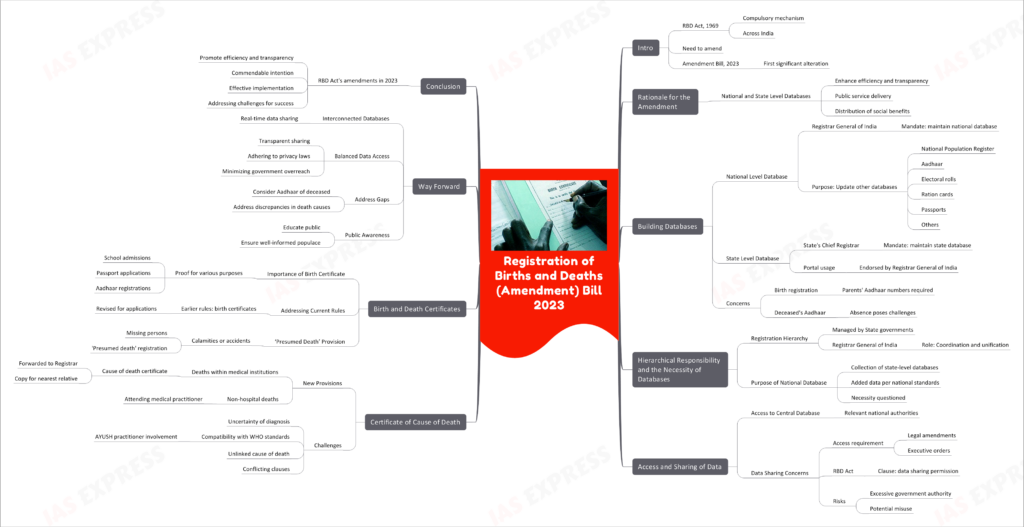Registration of Births and Deaths (Amendment) Bill- Why Amend the 1969 Act?

The Registration of Births and Deaths (RBD) Act, 1969, established a compulsory mechanism for registering births and deaths across India. However, as time has progressed, there’s a recognized need to amend this Act. With this intent, the Registration of Births and Deaths (Amendment) Bill, 2023, was passed, marking the first significant alteration since the Act’s inception.

Rationale for the Amendment
- National and State Level Databases: The amendment seeks to develop a National and State level database of registered births and deaths.
- The overarching objective is to enhance the efficiency and transparency in public service delivery and distribution of social benefits.
Building Databases
- National Level Database:
- The Registrar General of India is mandated to maintain a national level database.
- Purpose: Updating databases like the National Population Register, Aadhaar, electoral rolls, ration cards, passports, and others.
- State Level Database:
- Each state’s Chief Registrar must maintain a state-level database.
- Usage of a portal endorsed by the Registrar General of India is compulsory.
- Concerns:
- The amendments require parents’ Aadhaar numbers during birth registration.
- Absence of provisions regarding collecting Aadhaar of the deceased poses challenges in updating databases effectively.
Hierarchical Responsibility and the Necessity of Databases
- Registration Hierarchy: Managed predominantly by the State governments.
- The Registrar General of India’s role is primarily coordinating and unifying registration systems.
- Purpose of National Database:
- It is essentially a collection of state-level databases, with some added data as per national standards.
- Questions arise regarding the necessity of a national database when state-level databases already exist and can be interconnected efficiently.
Access and Sharing of Data
- Access to Central Database: The central-level database should be accessible to relevant national authorities.
- Data Sharing Concerns:
- If external authorities need access, legal amendments or executive orders might be necessary.
- The RBD Act might only require a clause permitting data sharing.
- Risks: Granting the government excessive authority in determining database additions can lead to potential misuse.
Certificate of Cause of Death
- New Provisions:
- For deaths within medical institutions, a cause of death certificate must be forwarded to the Registrar and a copy given to the nearest relative.
- For non-hospital deaths, the attending medical practitioner during the deceased’s recent illness must issue the certificate.
- Challenges:
- Uncertainty of diagnosis prior to death.
- Compatibility issues with WHO standards, especially if attended by AYUSH practitioners.
- Possibility of deaths from causes not linked to the treatment.
- Conflicting clauses about including cause of death in issued certificates.
Birth and Death Certificates
- Importance of Birth Certificate:
- It serves as a crucial proof for various purposes like school admissions, passport applications, and Aadhaar registrations.
- Addressing Current Rules:
- Earlier rules made birth certificates mandatory for certain applications, such as passports. This has been revised.
- ‘Presumed Death’ Provision:
- In the face of calamities or accidents where persons go missing, a ‘presumed death’ registration can expedite the process of issuing death certificates and provide closure to families.
Way Forward
- Interconnected Databases: Promote real-time data sharing between state and national databases.
- Balanced Data Access: Ensure data sharing is transparent, adhering to privacy laws and minimizing government overreach.
- Address Gaps: Further amendments should consider the Aadhaar details of the deceased and address the discrepancies in the cause of death clauses.
- Public Awareness: It’s crucial to educate the public about the changes, ensuring they are well-informed and can avail services seamlessly.
Conclusion
The RBD Act’s amendments in 2023 bring forth several enhancements aimed at promoting efficiency and transparency. However, while the intention is commendable, effective implementation and addressing the challenges mentioned will determine its ultimate success.
Practice Question for Mains
Critically evaluate the recent amendments in the Registration of Births and Deaths (Amendment) Bill, 2023. Discuss its objectives, potential implications, and challenges, especially in the context of promoting efficient and transparent public service delivery. (250 words)
If you like this post, please share your feedback in the comments section below so that we will upload more posts like this.

